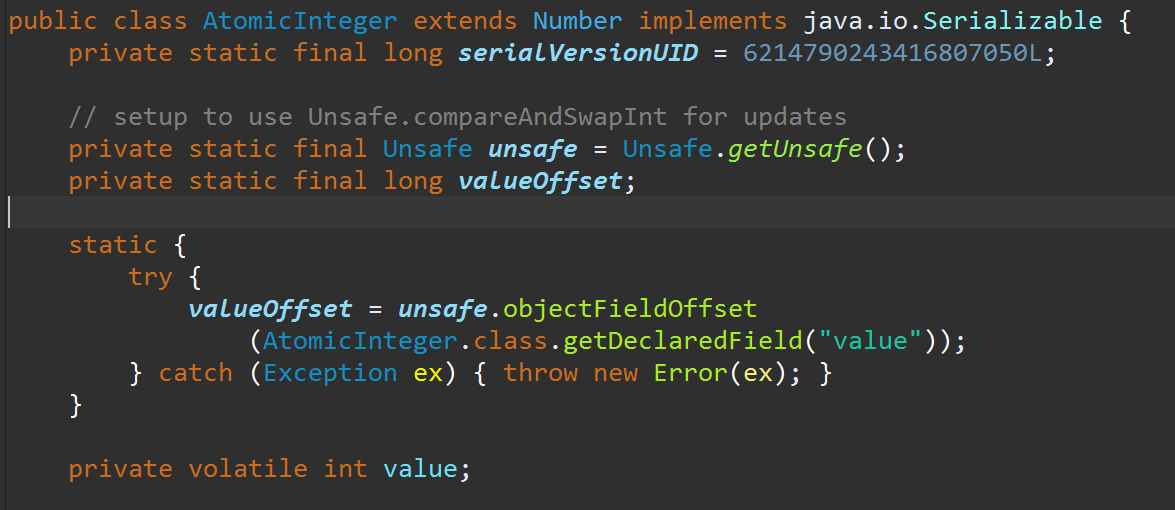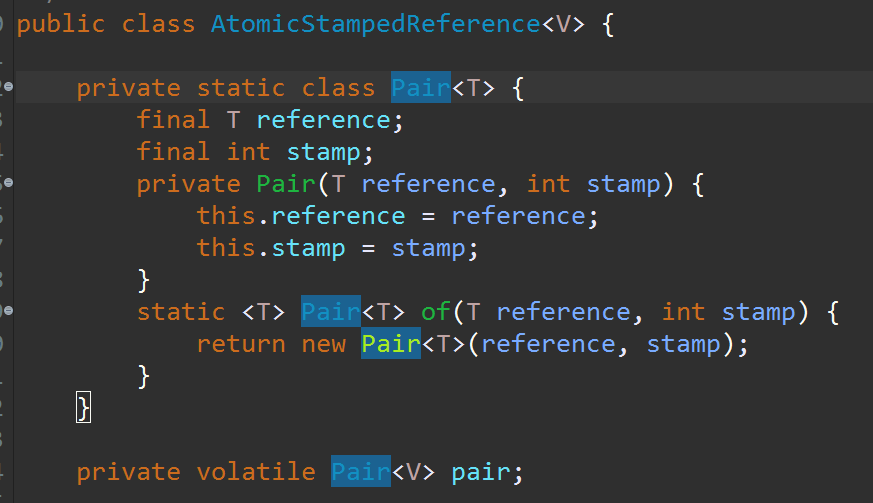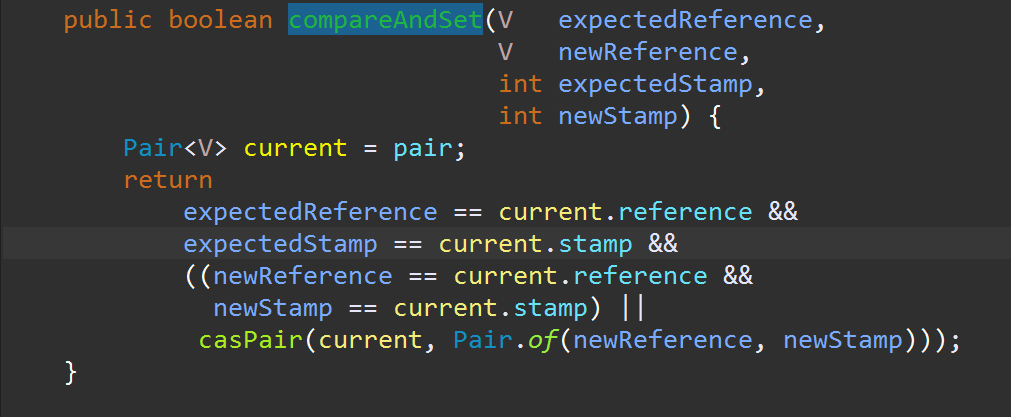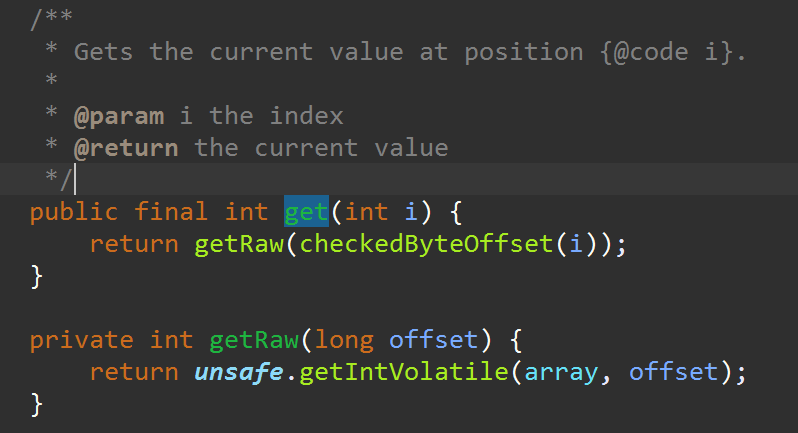一、无锁类的原理详解
无锁的概念就是无障碍运行,无障碍是指所有的线程都能进入临界区,无锁在无障碍的基础上加上了一条就是每次竞争必然有一条能够胜出。理论上无障碍有可能线程都失败,所以无锁更切实可行,但实践上无障碍和无锁差不多。
(一)CAS(Compare And Swap)
CAS算法的过程是这样的,它包含三个参数CAS(V,E,N)。V表示要更新的变量,E表示预期值,N表示新值。仅当V值等于E值时,才会将V的值设为N,如果V值和E值不同,则说明已经有了其它线程做了更新,则当前线程什么都不做。最后CAS返回V的真实值,CAS操作是抱着乐观态度进行的,它总是认为自己可以成功完成操作。当多个线程同时使用CAS操作一个变量时,只有一个会胜出,并成功更新,其余均会失败,失败的线程不会被挂起,仅是被告知失败,并且允许再次尝试,当然也允许失败的线程放弃操作。基于这样的原理,CAS操作即使没有锁,也可以发现其它线程对当前线程的干扰,并进行恰当的处理。
CAS思路:现在要对数据进行赋值,这个数据是在临界区中,需要被保护的一个数据,因为我要对这个数据进行赋值,现在假如有多个线程同时进来,应该是只有一个线程是能够胜出的,那么怎么判断哪个线程是可以成功的,现在要求线程对数据操作时给出一个期望值 ,如果数据的实际值和期望值是相符的,那么就可以把数据设置下去 ,否则就只能失败,因为如果期望的数值和实际的数值不相符,那么就有可能数据在操作的间隙当中已经被其它线程修改过了,因为数据已经被其它线程修改过了,所以这一次就不能修改了,想修改这个数据要等到下一次。所以每一次CAS操作先去读一下当前值是多少,读出来之后再去做一次CAS操作,你把期望值跟你刚才读出来的数据做一个比较,如果比较成功,然后就把新的值设上去。CAS总是抱着乐观的态度进行操作,它认为自己很有可能是能够完成这个事情的,所以它不会觉得完不成怎么办,完不成要重试,CAS它认为这个重试的概率是很小的,所以就可以直接去做。
(二)CPU指令

所以不存在因为步骤多,而导致步骤之间被其它线程干扰的问题。
CAS整的一个操作过程是一个原子操作,它是由一条CPU指令完成,并不是把取数据,比较,设值是有好多条CPU指令完成,它只是有一条CPU指令完成。
例如cmpxchg指令,它的逻辑就是比较目标值跟我寄存器的值是不是相等,如果相等就设置一个跳转标志,并且把原始数据设置到目标里面,否则跳转标志就不设置了,所以CAS从指令层面保证它这个操作是可靠的,有效的。
二、无锁类的使用
Java当中提供了一些无锁类的使用,所谓无锁类就是它在底部使用比较交换指令来实现的。与阻塞的方式相比,一般认为这种有锁的方式因为有了锁,所以线程会阻塞,会挂起,甚至它在进入临界区之前,由系统对它进行的阻塞和挂起,相对来讲无锁的方式性能会更好一些,因为一般来说,除非你去人为的挂起这个线程,否则你通过无锁的方式这个线程是不能被挂起的,它只会不断的做重试。一个线程如果在操作系统层面被挂起,那么它做一次上下文交换大概需要8万个时钟周期,但是如果只是做一个重试操作,只需要很少的时钟周期,因此在这种情况下相当于在拿一个很小的成本去节省8万个时钟周期的成本,除非运气很差,一直重试不成功,但基本上都是节省时间提高效率的,无锁的方式要比阻塞的方式性能好很多,
(一)AtomicInteger
1. 概念
AtomicInteger类位于java.util.concurrent.atomic包下,继承于Number类,Integer类也继承于Number类,Number类表示一个数字。
2. 主要接口
(1)public final int get() //取得当前值
(2)public final void set(int newValue) //设置当前值
(3)public final int getAndSet(int newValue) //设置新值并返回旧值
(4)public final boolean compareAndSet(int expect, int update) //如果当前值为expect,则设置为update
(5)public final int getAndIncrement() //当前值加1,返回旧值
(6)public final int getAndDecrement() //当前值减1,返回旧值
(7)public final int getAndAdd(int delta) //当前值加delta,返回旧值
(8)public final int incrementAndGet() //当前值加1,返回新值
(9)public final int decrementAndGet() //当前值减1,返回新值
(10)public final int addAndGet(int delta) //当前值增加delta,返回新值
3. 主要接口的实现

AtomicInteger类内部有一个非常重要的字段value,value字段其实是AtomicInteger封装的一个字段,也就是内部所有的操作都是对value做的,value才是内部的一个真正的值,atomic是对它的包装而已。

compareAndSet函数:参数expect代表期望值,参数update代表更新的新值,如果成功返回true,失败返回false。如果返回false代表实际的值和期望的值不一样。这里用到了unsafe操作,unsafe是一个不安全的操作。Java相对于C或C++更安全,是因为Java封装了指针的操作,而unsafe恰恰相反,在java相对于比较底层,提供一些类似指针的操作。unsafe.compareAndSwapInt(this,valueOffset,expect,update)函数是在这个类的valueOffset偏移量上看它的值是多少
在JDK1.7中getAndIncrement函数实现如下:

getAndIncrement函数首先取得当前值,然后再加1。
首先取得当前值(current),然后加1(next),因此加1的值一定是当前值基础上加1,不可能是已经改过的中间变量加1。然后比较compareAndSet,期望值是当前值,目标时next,如果我在做完加1操作后,有其它线程先我一步,修改了这个变量的值,那就会导致实际的current和期望的current不相符,所以这个设置必然失败。如果这个设置失败,compareAndSet函数返回false,走不到return,继续for循环,直到成功,返回当前值。
4.代码示例
1 import java.util.concurrent.atomic.AtomicInteger; 2 3 public class AtomicIntegerDemo { 4 static AtomicInteger i = new AtomicInteger(); 5 public static class AddThread implements Runnable{ 6 7 @Override 8 public void run() { 9 for(int k = 0; k < 10000; k++) { 10 i.getAndIncrement(); 11 } 12 } 13 14 } 15 16 public static void main(String[] args) throws InterruptedException { 17 Thread[] ts = new Thread[10]; 18 for(int m = 0; m < 10; m++) { 19 ts[m] = new Thread(new AddThread()); 20 } 21 for(int k = 0; k < 10; k++) { 22 ts[k].start(); 23 } 24 for(int k = 0; k < 10; k++) { 25 ts[k].join();; 26 } 27 System.out.println(i); 28 } 29 }
(二)Unsafe
1.概述
非安全的操作,比如:根据偏移量设置值,park(),底层的CAS操作。
非公开的API,在不同版本的JDK中,可能有较大的差异。
根据偏移量设置值:

unsafe有一个函数objectFieldOffset,获得AtomicInteger这个类的对象的value字段在这个对象上的偏移量。根据AtomicInteger对象的基地址,加上偏移量,就可以拿到value字段的地址,进而可以对value字段进行操作。
park():把线程停下来
底层的CAS操作:compareAndSwap函数就是在unsafe中实现的。
2. 主要接口
(1)public native int getInt(Object o, long offset); //获得给定对象偏移量上的int值
(2)public native void putInt(Object o, long offset, int x); //设置给定对象偏移量上的int值
(3)public native long objectFieldOffset(Field f); //获得字段在对象中的偏移量
(4)public native void putIntVolatile(Object o, long offset); //设置给定对象的int值,使用volatile语义(其它线程马上能看到我的改动)
(5)public native int getIntVolatile(Object o, long offset); //获得给定对象的int值,使用volatile语义(其它线程马上能看到我的改动)
(6)public native void putOrderedInt(Object o, long offset, int x); //和putIntVolatile()一样,但是它要求被操作字段就是volatile类型的
(三)AtomicReference
1. 概述
对引用进行修改。
是一个模板类,抽象化了数据类型。
AtomicReference和AtomicInteger相比,AtomicInteger封装的是一个整数,AtomicReference封装的是一个对象的引用,只要对对象引用进行修改,就可以使用AtomicReference保证线程安全。
AtomicReference是一个模板,它带有模板变量V,表示它可以封装任意类型的数据。
2. 主要接口
(1)public final V get(); //获得当前值
(2)public final void set(V newValue); //设置当前值为新值
(3)public final boolean compareAndSet(V expect, V update); //如果当前值为expect,则设置为update
(4)public final V getAndSet(V newValue); //设置新值newValue,返回旧值。
3.代码示例
1 import java.util.concurrent.atomic.AtomicReference; 2 3 public class AtomicReferenceTest { 4 public final static AtomicReference<String> atomicStr = new AtomicReference<String>("abc"); 5 6 public static void main(String[] args) { 7 for(int i = 0; i < 10; i++) { 8 new Thread(""+i){ 9 public void run() { 10 try { 11 Thread.sleep((int)(Math.random()*100)); 12 } catch (InterruptedException e) { 13 // TODO Auto-generated catch block 14 e.printStackTrace(); 15 } 16 if(atomicStr.compareAndSet("abc", "def")) { 17 System.out.println(Thread.currentThread().getName() + " successed!"); 18 } else { 19 System.out.println(Thread.currentThread().getName() + " failed!"); 20 } 21 } 22 }.start(); 23 } 24 } 25 }
(四)AtomicStampedReference
1.概述
AtomicStampedReference也是一个对象的引用,但是加了stamped(邮戳,时间戳),也就是一个有唯一性标识的字段,时间戳可以认为是一个stamped,一个递增上去的不重复的数据可以认为是一个stamped,这是为了解决ABA问题。
ABA问题:有一个reference是A,然后我们把它改成了B,再然后把它改成了A。在这种情况下,有一个线程1首先拿到了reference是A,接着它会做一些自己额外的操作,比如说它会做一些计算,接着线程1开始准备赋值,这时候有另外一个线程2把A改成了B,又有一个线程把B改回到了A。线程1计算完毕后开始做CAS操作,它读了一下,发现还是A,它觉得这个数据没有被人改过,所以它就成功的把这个数据设置回去了,比如设置成C。这样一个过程,如果仅仅只是一个简单的加法,那可能问题不大,因为跟过程状态无关的,只跟最终结果相关,所以可以把数据设置上去,答案也不会错。但是有些情况之下,我们设置数据可能更它的过程状态相关,比如要给每个账户余额小于10元的用户充值10元,每个用户充值1次,不能因为花了这10元,再次充值,这是不行的,当你对数据的变化过程敏感的时候,是没有办法区分前面的A和后面的A,如果要区分,有一个办法就是给每一个对象都加上一个stamped,假设A为S,B为S+1,改后的A为S+2。如果要对数据进行赋值的时候,不仅仅要看A是不是A,还要看S是不是S,此时设置失败。确保在过程状态敏感的数据不会出现问题。
2.主要接口
(1)public boolean compareAndSet(V expectedReference, V newReference, int expectedStamp, int newStamp); //比较设置参数依次为:期望值 写入新值 期望时间戳 新时间戳
(2)public V getReference(); //获得当前对象引用
(3)public int getStamp(); //获得当前时间戳
(4)public void set(V newReference, int newStamp); //设置当前对象引用和时间戳
3.内部实现

AtomicStampedReference类内部封装了一个Pair,Pair内部首先是我们要用的数据reference,对于AtomicReference来讲,内部是一个value,现在把value做了一层封装,包装在Pair里面,另外还有一个stamp,stamp就是在应用层设置的,最好不要让它重复的一个数据,stamp决定了数据能不能设置成功。of方法是一个静态的工厂方法,它根据reference和stamp来生成一个Pair的实例。

当你去拿reference的时候,返回的是pair的reference。

当你去拿stamp的时候,返回的是pair的stamp。


当你去设置这个pair的时候,你需要提供期望的引用数据,新对象引用,期望的stamp值,新的stamp值。只有当期望的引用值等于当前的引用值,并且期望的stamp等于当前的stamp情况下,并且设置结果成功,返回true。
4.代码示例
1 import java.util.concurrent.atomic.AtomicStampedReference; 2 3 public class AtomicStampedReferenceDemo { 4 static AtomicStampedReference<Integer> money = new AtomicStampedReference<Integer>(19, 0); 5 6 public static void main(String[] args) { 7 //模拟多个线程同时更新后台数据,为用户充值。 8 for(int i = 0; i < 3; i++) { 9 final int timestamp = money.getStamp(); 10 new Thread() { 11 public void run() { 12 while(true) { 13 while(true) { 14 Integer m = money.getReference(); 15 if(m < 20) { 16 if(money.compareAndSet(m, m+20, timestamp, timestamp+1)) { 17 System.out.println("余额小于20元,充值成功,余额:" 18 + money.getReference() + "元!"); 19 } 20 }else { 21 break; 22 } 23 } 24 } 25 } 26 }.start(); 27 } 28 29 //用户消费线程,模拟消费行为 30 new Thread() { 31 public void run() { 32 for(int i = 0; i < 100; i++) { 33 while(true) { 34 int timestamp = money.getStamp(); 35 Integer m = money.getReference(); 36 if(m > 10) { 37 System.out.println("大于10元"); 38 if(money.compareAndSet(m, m-10, timestamp, timestamp+1)); 39 System.out.println("成功消费10元,余额:" + money.getReference()+"元"); 40 } else { 41 System.out.println("没有足够的金额"); 42 break; 43 } 44 try { 45 Thread.sleep(100); 46 }catch (Exception e) { 47 // TODO: handle exception 48 } 49 } 50 } 51 } 52 }.start(); 53 54 } 55 }
(五)AtomicIntegerArray
1.概述
支持无锁的数组
2.主要接口
public final int get(int i); //获得数组第i个下标的元素
public final int length(); //获得数组的长度
public final int getAndSet(int i, int newValue); //将数组第i个下标的值设置为newValue,并返回旧值
public final boolean compareAndSet(int i, int expect, int update); //进行CAS操作,如果第i个下标的元素等于expect,则设置为update,设置成功返回true。
public final int getAndIncrement(int i); //将第i个下标的元素加1
public final int getAndDecrement(int i); //将第i个下标的元素减1
public final int getAndAdd(int i, int delta); //将第i个下标的元素增加delta(delta可以是负数)
3.接口实现

内部封装了一个普通的数组array,也不需要声明为volatile。




当试图去get的时候,内部有一个方法是getRaw方法,取得array基地址上偏移量为offset的int值。checkedByteOffset取得第i个位置的元素在array上的偏移量。相对来讲比较高性能的实现会调用地址偏移量的方式。首先这个base是数组的基地址,也就是它第一个元素所在的基地址。如果是第i个,偏移了shift个地址。
LeadingZeros是前导零,一个数字把它换成二进制后,前面零的个数。我们整数是32位,例如整数4,0...0100,前面把零写满,正好是29个,arrayIndexScale是指数组中每一个元素有多宽,对int来讲,是4个byte,对int来讲,scale是4。所以前导零就是29,shift就是2。
每个元素的偏移量是:base+(i*4),用位运算表示就是:base+(i<<2)。
JDK大量使用位运算等高性能运算方式。
4.代码示例
1 import java.util.concurrent.atomic.AtomicIntegerArray; 2 3 public class AtomicIntegerArrayDemo { 4 private static AtomicIntegerArray array = new AtomicIntegerArray(10); 5 public static class AddThread implements Runnable{ 6 7 @Override 8 public void run() { 9 for(int k = 0; k < 100000; k++) { 10 array.getAndIncrement(k%array.length()); 11 } 12 } 13 14 } 15 16 public static void main(String[] args) throws InterruptedException { 17 Thread[] ts = new Thread[10]; 18 for(int k = 0; k < 10; k++) { 19 ts[k] = new Thread(new AddThread()); 20 } 21 for(int k = 0; k < 10; k++) { 22 ts[k].start(); 23 } 24 for(int k = 0; k < 10; k++) { 25 ts[k].join(); 26 } 27 System.out.println(array); 28 } 29 }
(六)AtomicIntegerFieldUpdater
1.概述
让普通变量也享受到原子操作。
比如:在系统代码中可能会使用一些成员变量,可能最开始简单定义成int,可能并没有定义成AtomicInteger,后面开发中,希望使用CAS操作,但又不想去改数据类型,因为会牵连很多东西。这时候可以选择AtomicIntegerFieldUpdater。
2.主要接口
(1)AtomicIntegerFieldUpdater.newUpdater()
(2)incrementAndGet()
3.小说明
(1)Updater只能修改它可见范围内的变量。因为Updater使用反射得到这个变量。如果变量不可见,就会出错。比如如果score声明为private,就是不可行的。
(2)为了确保变量被正确的读取,它必须是volatile类型的,如果我们原有代码中未声明这个类型,那么简单的声明一下就行,这不会引起什么问题。
(3)由于CAS操作会通过对象实例中的偏移量直接进行赋值,因此,它不支持static字段(Unsafe.objectFieldOffset()不支持静态变量)。
4.代码示例
1 import java.util.concurrent.atomic.AtomicInteger; 2 import java.util.concurrent.atomic.AtomicIntegerFieldUpdater; 3 4 public class AtomicIntegerFieldUpdaterDemo { 5 public static class Candidate{ 6 int id; 7 volatile int score; 8 } 9 10 public final static AtomicIntegerFieldUpdater<Candidate> scoreUpdater = 11 AtomicIntegerFieldUpdater.newUpdater(Candidate.class, "score"); 12 13 //检查updater是否正确工作 14 public static AtomicInteger allScore = new AtomicInteger(0); 15 16 public static void main(String[] args) throws InterruptedException { 17 final Candidate stu = new Candidate(); 18 Thread[] ts = new Thread[10000]; 19 for(int i = 0; i < 10000; i++) { 20 ts[i] = new Thread() { 21 public void run() { 22 if(Math.random() > 0.4) { 23 scoreUpdater.getAndIncrement(stu); 24 allScore.getAndIncrement(); 25 } 26 } 27 }; 28 ts[i].start(); 29 } 30 for(int i = 0; i < 10000; i++) { 31 ts[i].join(); 32 } 33 System.out.println(stu.score); 34 System.out.println(allScore); 35 } 36 }
三、无锁算法详解
1 import java.util.AbstractList; 2 import java.util.concurrent.atomic.AtomicReference; 3 import java.util.concurrent.atomic.AtomicReferenceArray; 4 5 public class LockFreeVector<E> extends AbstractList<E> { 6 7 private static final boolean debug = false; 8 9 /** 10 * size of the first bucket. 11 * sizeof(bucket[i+1]) = 2*sizeof(bucket[i]) 12 */ 13 private static final int FIRST_BUCKET_SIZE = 8; 14 15 /** 16 * number of buckets 17 * 30 will allow 8*(2^30-1) elements 18 */ 19 private static final int N_BUCKET = 30; 20 21 /** 22 * we will have at most N_Bucket number Of buckets, 23 * and we have sizeof(bucket.get(i)) = FIRST_BUCKET_SIZE**(i+1) 24 */ 25 private final AtomicReferenceArray<AtomicReferenceArray<E>> buckets; 26 27 static class WriteDescriptor<E>{ 28 public E oldV; 29 public E newV; 30 public AtomicReferenceArray<E> addr; 31 public int addr_ind; 32 33 /** 34 * Creating a new descriptor 35 * 36 * @param addr Operation address 37 * @param addr_ind index of address 38 * @param oldV old operand 39 * @param newV new operand 40 */ 41 public WriteDescriptor(AtomicReferenceArray<E> addr, int addr_ind, E oldV, E newV) { 42 this.addr = addr; 43 this.addr_ind = addr_ind; 44 this.oldV = oldV; 45 this.newV = newV; 46 } 47 48 /** 49 * set newV 50 */ 51 public void doIt() { 52 addr.compareAndSet(addr_ind, oldV, newV); 53 } 54 } 55 56 static class Descriptor<E> { 57 public int size; 58 volatile WriteDescriptor<E> writeop; 59 60 /** 61 * create a new descriptor 62 * @param size the size of vector 63 * @param writeop executor write operation 64 */ 65 public Descriptor(int size, WriteDescriptor<E> writeop) { 66 this.size = size; 67 this.writeop = writeop; 68 } 69 70 71 public void completeWrite() { 72 WriteDescriptor<E> tmpOp = writeop; 73 if(tmpOp != null) { 74 tmpOp.doIt(); 75 writeop = null; //this is safe since all write to writeop use null as r_value 76 } 77 78 } 79 } 80 81 private AtomicReference<Descriptor<E>> descriptor; 82 private static final int zeroNumFirst = Integer.numberOfLeadingZeros(FIRST_BUCKET_SIZE); 83 84 /** 85 * constructor 86 */ 87 public LockFreeVector() { 88 buckets = new AtomicReferenceArray<AtomicReferenceArray<E>>(N_BUCKET); 89 buckets.set(0, new AtomicReferenceArray<E>(FIRST_BUCKET_SIZE)); 90 descriptor = new AtomicReference<Descriptor<E>>(new Descriptor<E>(0,null)); 91 } 92 93 /** 94 * add e at the end of vector 95 * 96 * @param e element added 97 */ 98 public void push_back(E e) { 99 Descriptor<E> desc; 100 Descriptor<E> newd; 101 do { 102 desc = descriptor.get(); 103 desc.completeWrite(); 104 105 int pos = desc.size + FIRST_BUCKET_SIZE; 106 int zeroNumPos = Integer.numberOfLeadingZeros(pos); 107 int bucketInd = zeroNumFirst - zeroNumPos; 108 if(buckets.get(bucketInd) == null) { 109 int newLen = 2 * buckets.get(bucketInd - 1).length(); 110 if(debug) 111 System.out.println("New Length is : " + newLen); 112 buckets.compareAndSet(bucketInd, null, new AtomicReferenceArray<E>(newLen)); 113 } 114 115 int idx = (0x80000000>>>zeroNumPos) ^ pos; 116 newd = new Descriptor<E>(desc.size + 1, new WriteDescriptor<E>( 117 buckets.get(bucketInd),idx,null,e)); 118 } while(!descriptor.compareAndSet(desc, newd)); 119 descriptor.get().completeWrite(); 120 } 121 122 @Override 123 public E get(int index) { 124 // TODO Auto-generated method stub 125 return null; 126 } 127 128 @Override 129 public int size() { 130 // TODO Auto-generated method stub 131 return 0; 132 } 133 134 }